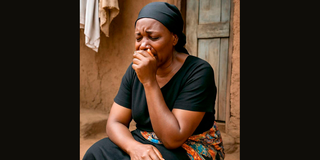Invisible women: How Kenya's widows are missing from the numbers that matter

Kenya's widows are missing from the numbers that matter - from Nairobi to rural Meru, they are falling through statistical cracks that determine government support and policy.
What you need to know:
- Estimates of Kenya's widows range wildly from 1.4 to 8 million because they're not counted as a distinct group in national statistics.
- Advocates now want widows included separately in the census, arguing that without proper data, there can be no targeted policies or state support.
When Faith Karambu lost her husband to cancer in 2019, she was just 36 years old, struggling to hold her family together. A casual worker with Nairobi County, she often went months without pay.
Then came Covid-19 in 2020. Bills mounted, and with three children to raise on her own, the burden of widowhood became overwhelming.
“I was falling apart,” she recalls.
“Imagine losing my husband, being financially drained because his treatment exhausted all our savings, and then having no job, because I had to quit after going for seven months without pay.”
Eventually, overwhelmed and teetering on the edge of depression, Faith left Nairobi and returned to her rural home in Meru County. She hoped for peace, but what she found was an even deeper silence, which she describes as being erased from the system.
“I realised widows like me don’t exist in the eyes of the government. We are just... invisible,” she says.
“I met other widows who had suffered enough, and the government was nowhere to be found to help them.”
Widow rights advocates attribute this lack of intervention to the absence of official data, which is crucial for informing targeted policies and laws to alleviate their burdens.
Also read: The man who makes land grabbers tremble
Estimates vary widely; some organisations suggest 1.4 million, others up to 8 million, but widows are not officially recognised as a distinct category in national statistics.
Now, they want the Kenya National Bureau of Statistics to include them in the census as a distinct group and not be lumped together as “widowed.” which applies to both widows and widowers.
“Numbers drive policy,” says Dianah Kamande, the founder and executive director of Come Together Widows and Orphans Organisation.
“If you’re not counted, you’re not considered.”
Yet laws exist that promote the rights of the widows.
“We have laws such as the Law of Succession Act, Matrimonial Property Act, Marriage Act, and the Protection against Domestic Violence Act, but laws should go hand-in-hand with the data,” she explains.
“The figures will tell where to start with the widows and how to start.”
National data
Meanwhile, the organisation has developed a widows' resource guide, a toolkit that helps widows navigate inheritance processes, understand their legal rights, access legal aid and psychosocial support, and connect with government programs.
As Kenya marks this year’s International Widows Day under the theme “Rights, Dignity and Justice,” Dianah underscores the importance of ensuring widows are visible in national data.
“When widows are missing from statistics, they are missing from development plans. It’s like trying to build a house without knowing how many people will live in it,” she says.
“Widows don’t need pity. They need protection. They need to be heard and counted not just as a number, but as women who’ve endured loss and deserve dignity,” she affirms.


